Ardmulchan
Ardmulchan
Mounds and Church Ruins
Neither the manor of Ardmulchan nor the church had any association with the de Feipos, (the Barons of Skryne) but were retained by deLacy himself. At some time before 1199 Ardmulchan was granted to Theobald Walter le Botiller. We know this from a charter executed by Theobald Walter and witnessed by among others Meiler Fitzhenry, then Justiciar (1199 -1203). By this charter, Theobald grants the church and chapels of Ardmulchan to the monks of the Abbey of St. Thomas the Martyr in Dublin.
This was at a time when defence of the Boyne was vital to establishment of the Norman colony in Meath. A substantial motte was built on the height above the river, and a church and several chapels rebuilt on pre Norman foundations. The church tower may be as early as 13th or 14th cent. The present ruins of the church seem to be 15th cent. judging from the remaining stones from a fine mullioned east window. (below).
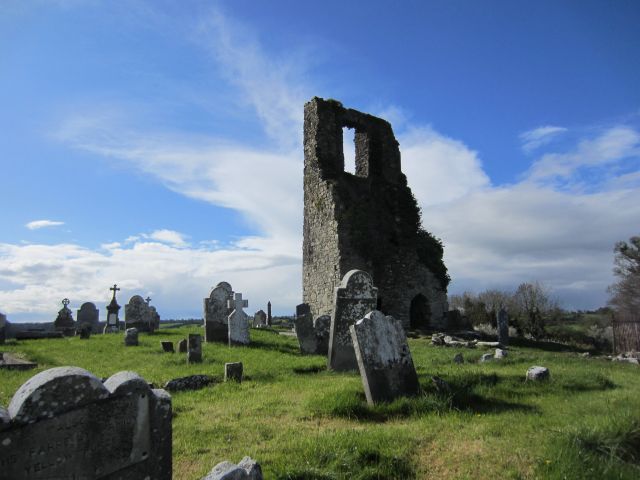
(Photo: © Navan & District Historical Society)
By 1212 the manor had reverted to the deLacy family. From the Irish pipe roll we can gain some knowledge of its agricultural potential at this period. The rent from "the whole manor of Ardmulchan" was £23.12.4 per annum which can be compared with £27.12.8 for Kells and £12.19.2 from the manor of Fore.
The Manor of Ardmulchan remained in the hands of the deLacys, and from them passed on to the de Genevilles. An amusing incident is recorded in 1297 when the sherrif went to execute a warrant for debt against one of the deGenevilles. He failed to collect the debt, and returned the following information:
"...that Nich, Passelewe, serjent of the King went to the town of Geoffrey de Genevyll at Ardmolghan to execute the writ, and all the men of that town deforced him of the cattle which he had in his possession."
The temporalities of the church did not remain with the monks of St. Thomas's Abbey. They appear to have been recovered by Bishop de la Corner and presented by him to his sister's convent at Lismullin.
Source: Skryne and the Early Normans, Elizabeth Hickey (MAHS 1994)
*******
Church Ruins - Ordnance Survey Fieldname Book 1836
Found in the west end of Ardmulchan townland near the Boyne, the ruins consist of a square tower or belfry (right) and some remains of the old church, which measured internally 78 feet 2 inches.
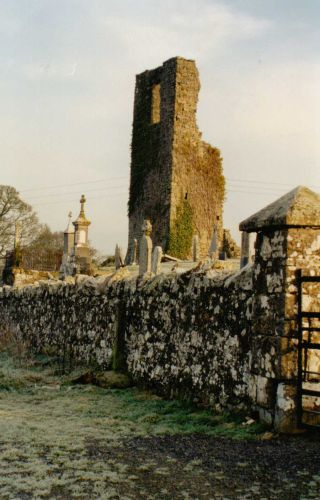
They stand in an ancient graveyard, (below) containing many interesting tombstones. The church was dedicated to the Blessed Virgin.
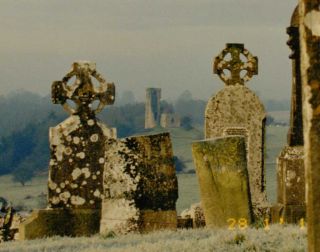
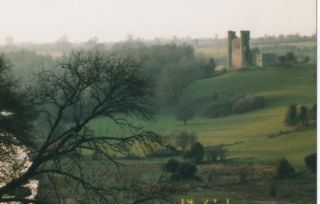
Towards Dunmoe Castle from Ardmulchan
(Photos: © Navan & District Historical Society)
*******
Ardmulchan Mounds and Church Ruins
Ordnance Survey Fieldname Book, 1836
Mound
In the west end of Ardmulchan townland, a short distance beyond the church and near the Boyne. This is a circular mound, surrounded with a fosse and rampart. It is planted with trees. In the north east end of Ardmulchan townland near the Boyne, an ancient fort, enclosed with fences and planted.
Ardmulkin Demesne - Ordnance Survey Fieldname Book 1836
The demesne is situated in the north west part of the townland of Ardmulchan. It is the seat of R. Taafe Esquire. There is a good dwelling house with office houses and a garden. The River Boyne and the Drogheda Canal bounds it to the northwest. It is bounded on the southeast by the road from Navan to Drogheda.
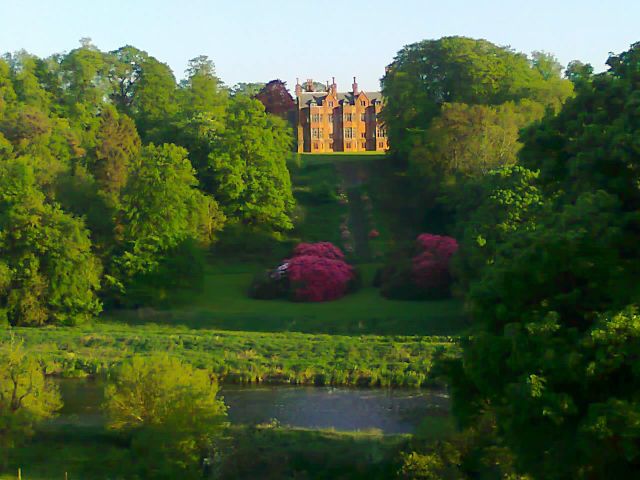
(Photos: © Navan & District Historical Society)
(above) Ardmulchan House viewed from across the river at Dunmoe Castle.
*
Ardmulchan Castle is a Scottish Baronial cum Elizabethan hunting lodge dating to 1904. The house was built for a Scottish landowner, Fitzroy C. Fletcher, who died before the house was completed. Set dramatically high up on the south banks of the river Boyne below Navan the house has been described as a Scotsman's house in Ireland by Casey and Rowan. The house was built for entertaining with five guest bedrooms and plenty of space for staff. It has a very ornate porch, front door and portico. The house had its own electricity provided by a powerhouse near the river with the front door of the old house was re-used as the door of the powerhouse. The tower of the house with its battlements stores the water tanks. The long internal hall is at right angles to the door with the principal rooms overlooking the Boyne. The hall has high oak panelling. The rooms have plasterwork ceilings created by G. Rome & Co, a firm which practised in Dublin and Glasgow. All the rooms have elaborate chimney pieces and a number have angle nooks.
The Taaffes acquired Ardmulchan in the eighteenth century and erected a plain Georgian style house overlooking the river. The family burial ground is at Ardmulchan cemetery. Taaffe‟s lock on the Boyne Canal commemorates their financial contribution to the canal company.
Fitzroy Charles Fletcher of Angus in Scotland married Frances May Grant, from Australia in 1890. Fletcher enjoyed hunting and regularly visited his friend, Robert Gradwell of Dowth Hall, County Meath. Fletcher rented Slane Castle from the Conynghams for a number of hunting seasons, hunting in Ireland from November to March Fletcher decided to purchase a permanent residence in Ireland. With the assistance of Gradwell he found and purchased Ardmulchan House in 1900. The existing Georgian style house was not suitable for Fletcher's requirements and he decided to demolish the house and replace it with a hunting lodge.
The architect Fletcher selected was a Scotsman Sidney Mitchell of Edinburgh. Materials and workmen were despatched from Scotland. Lord Aberdeen, the Viceroy, appealed to Fletcher to use Irish craftsmen and materials but to no avail. Apart from some welding on some dog grates the rest of the works was all provided by Scottish workers. The sandstone for the windows was carved from a quarry on Fletcher's Scottish estate and transported by ship to Drogheda and then by barges along the canal to Ardmulchan. All the materials with the exception of the bricks were also Scottish. Casey and Rowan wrote that Fletcher can hardly have been popular in Meath for importing such a quantity of tradesmen. Fletcher's poor health forced him to delegate much of the work and decisions to the manager of his Scottish estates, James Stirling.
Construction made good progress but Fletcher died in August 1902. His will provided for £7,000 for the completion of Ardmulchan. His wife Mary Frances was given a life rent of all her husband's estates. Thomas Fletcher inherited Ardmulchan on the death of his mother. A noted horse breeder and huntsman, Thomas was director of Proudstown Park racecourse, Navan, from its inception in 1921. During the 1930s the house was rented to Sir Alexander Maguire of Maguire and Patterson matches. In 1939 his horse "Workman" won the Grand National, an event celebrated in Navan with an address by the Urban District Council to Sir Alexander. After the Second World War Thomas Fletcher moved across the Boyne to Dunmoe cottage and he died in 1950.
The Fletcher family remained in ownership of Ardmulchan until 1956 when the house and estate were sold to Anthony Riddell Martin and his family. When his young daughter died in she was interred in Ardmulchan cemetery and Riddell Martin had the intervening woods cleared so that the grave and cemetery could be viewed from the house. During the late 1960's the castle was owned by a German called Von Trapp and the estate was managed by an Englishman Hogarth. In 1973 it was purchased by Sean Galvin as a family home and is still in use as a family home today. Kathleen G. Mac Leman recorded much detail of Ardmulchan in her book; Fitzroy C. Fletcher of Letham Grange and Ardmulchan. A few years ago the Meath Archaeological and Historical Society was graciously allowed to visit the house courtesy of its owners.
SOURCE: meath-roots.com
*******
Ardmulchan Civil Parish
Ordnance Survey Field Name Book 1836.
Ardmulkin Parish - Boundary Sketch 1829.
Árd Mullacháin, the height or hill of the little summit.
Recte Árd - Maelchon, Maelchu's height or hill. Annals of the Four Masters.
Ardmulchan. John O'Donovan: Mr. Taafe has put the correct spelling of this name on the winkers of his horses.
Ardmulchan - Down Survey.
Ardmulchan - Civil Survey 1656-7.
This parish is situated in the barony of Skreen, on the high road from Navan to Drogheda. It is bounded on the north by Stackallen parish.
It is bounded on the north west by the parishes of Dunmoe and Donaghmore.
It is bounded on the west by Athlumney parish.
It is bounded on the south by the parishes of Follistown and Brownstown.
It is bounded on the east by Painestown parish.
It lies from 2 to 4 1/2 miles eastwards from Navan.
It contains 3,582 acres 1 rood 39 perches, statute measure, including 25 acres 20 perches of the River Boyne. About 2/3 of this parish is under tillage; the remainder is good grazing land. There is no waste or bog. The River Boyne and Drogheda Canal run on the northern boundary. The direct road between Navan and Drogheda on the southern bank of the river passes across the northern part of the parish, and the road from Navan to Donore via Lougher traverses the southern part. Gentlemen's seats in the parish are:- Ardmulchan Demesne, Hayestown Demesne and Kingstown House.
Townlands:
Ardmulchan. Harristown, Haystown and Carnuff Little. Kingstown and Carnuff Great.
Miscellaneous Features:
Ardmulchan Demesne
Haystown Demesne
Kingstown House
Mound
Ruins of Church
Geo. T. W. Brady, Lt. Roy. Engrs. 27th June 1836.
Civil Survey 1654-1656:
Ardmulchan. There are on the premisses a castle a church and a Tuck- mill with severall Cottages, and there lyeth a forde over the River of Boyne, And there are severall small cottages with Backsides, belonging to severall ffreeholders, all Irish papists.
*******
Topographical Dictionary of Ireland, 1837
Ardmulchan, a parish, in the barony of Skreen, county of Meath, and province of Leinster, 2 ½ miles (N. E.) from Navan; containing 1061 inhabitants. This parish is situated on the high road from Navan to Drogheda, and the new road from Trim to Duleek runs through the southern part of it: its northern part is intersected by the Boyne navigation. It comprises 3347 statute acres, as applotted under the tithe act: about two thirds are under tillage, and the remainder is good grazing land; there is no waste or bog. Limestone abounds, and there is a good quarry of stone for building. Ardmulchan House is the seat of R. Taaffe, Esq.; and Hayes, a handsome residence, of R. Bourke, Esq. The parish is in the diocese of Meath, and the rectory is united to Painstown: the tithes amount to £253. 16. 10 ½. In the R. C. divisions also it is part of the union or district of Black Lion or Painstown. There is a free school for boys and girls at Hayes, under the patronage of R.Bourke, Esq., who built the school house, gave an acre of land rent free, and allows £24 per ann. for its support; the girls' school is principally supported by Mrs. Bourke.
*******
Archaeological Inventory of County Meath, compiled by Michael J. Moore, (Dublin 1987), p.1
1 - ARDMULCHAN - OS 25:4:3 (86.0, 54.0) Not marked OD 100-200 N 918, 711
Megalithic Tomb (possible) - Two stones bearing megalithic art were found during construction of a house. A low mound beside the find-spot may represent the remains of a passage tomb. (Shee 1981, 225) SMR 25:6 23/2/1985.
p.57
471 - ARDMULCHAN OS 25:4:3 (88.6, 53.8) Hachured OD 100-200 N 9212, 7115
Ringfort - Raised oval area defined by scarp (dims. 38m N-S, 27m E-W) with external berm and outer scarp NNE-E. No visible fosse. Entrance may have been at ESE. SMR 25:7 27/5/1969
p.116
1190 Ardmulcahn OS 25:8:2 (78.1, 44.5) Not marked OD 100-200 N 9102, 7018
Rectilinear Enclosure - Rectangular area defined by earthen bank (dims. 20.7m NW-SE, 14.5m NE-SW) with two entrances on SW side where access is easiest. SMR 25:21
p.127
1331 Ardmulchan OS 25:8:1 (76.1, 44.7) 'Church (in ruins)' OD 100-200 N 9081, 7017
Church - Undivided nave and chancel (L 25/6m, W c. 7m) with only parts of foundations surviving. Bell tower with three storeys, vaulted ground floor and mural staircase, attached to W end of church. SMR 25:20
p.156
1604 Ardmulchan OS 25:4:4/25:8:1 (76.0, 45.6) Hachured OD 100-200 N9801, 7026
Motte - Flat topped mound of earth (top dims. 36m N-S, 27m E-W, dima of base 57m N-S, H 6.8m at N, 4.4m at S). Defined by bank around base which may be landscape feature as site was once planted with trees. SMR 25:19
*********
The Parliamentary Gazetteer 0f Ireland, 1844-1845, Vol. 1
ARDMULCAN, a parish in the barony of Skreen, 2 1/2 miles north east of Navan, Co. Meath, Leinster. Length, 2 miles; breadth, 1 1/2; area, 3,583 acres. Pop., in 1831, 1,060; in 1841, 1,038. Houses 168. The parish forms part of the immediate banks of the Boyne; and is rich in the features of verdure, wood, and cereal produce. Ardmulcan house is the seat of Robert Taafe, Esq.; and confronts, on the opposite side of the Boyne, the far stretching and well wooded demesne of Swinerton. This parish is a rectory in the dio. of Meath; and forms part of the benefice of Painstown. Tithe composition, £253 16s. lO 1/2d. here is neither church nor chapel. In 1834, the Protestants amounted to 119, and the Roman Catholics to 946; and a school of the London Hibernian Society had on its books 20 boys and 25 girls.
*******
Slater's Directory 1894
Ardmulchan a parish in Co. Meath, barony of Skreen, union of Navan, Protestant diocese of Meath, 2 1/2 miles north east from Navan station on the Great Northern (Ireland) railway, containing 4 townlands. Ardmulcham House, on the banks of the river Boyne, is the seat ofRobert Joseph Taaffe esq. The area comprises 3,582 acres; the population in 1891 was 373.
Private Residents:
Mayo, Earl of, Hayes.
Meldon, Albert J. R. M.
Taaffe, Robert Joseph, Ardmulchan Ho.
Commercial:
Fagan, Bryan, spirit dealer.
Farmers:
Carpenter, William, Harristown.
Clarke, James, Harristown.
Daly, Patrick, Harristown.
Farrell, John, jun. Harristown.
Healy, Joseph
Kelly, Christopher, Hayestown.
Mullen, Matthew.
Woodward, Thomas.